Application of Johnson in Telemann’s Don Quichotte (V1)
In this section I will apply the embodied gestalt schemata as conceived by Mark Johnson (1987) to my study of mimetic action (V1). As presented in the introduction to the Embodiment chapter 2.2 in the Theoretical framework, Johnson’s embodied image schemata are non-propositional ‘schematic structures that are constantly operating in our perception, bodily movement through space, and physical manipulation with objects’ (Johnson, 1987, p. 23).
As a further elaboration of my video analysis, I will use the schemata as tools for describing how I experience giving shape to an action, dance step, and poetic imagery on my violin. This will allow me to transcend questions concerning style by moving into the basic bodily experiences of interacting with the environment, such as weight, force, balance, resistance, etc. Characteristic features of baroque violin bowing can thus be revealed from within the performer’s experiential embodied vocabulary.
Belonging to the category of the metaphors of force, Johnson’s gestalt image schemata of blockage and compulsion (1987, p. 45) resonate closely with the schema of bow action in the “mean” Gavotte (V1aT3). The schema of compulsion (Ex. 1) captures the most basic embodied interaction with the environment, where the force exerted by a body sets the object positioned in the trajectory of the impact into motion.

Ex. 1 Gestalt image schema of compulsion (Johnson, 1987, p. 45).

Ex. 2 This is how I annotate the bow action in the score in relation to body movement.
The forward motion of the body needs to press against the resistance of the bow strokes, hence, in the following extract of the schema, the actual object which modifies the exerted force of the body movement (dotted line) is not the violin, but the movements of the bow hand (full line arrows).

Ex. 3 The annotation extracted from the musical score demonstrates the kinaesthetic energy of the interaction between the bow action and the body movement.
Vid1 The kinaesthetic forces applied in performance as bodily gestures.
The impact of the force is modified by the blockage. This might be a too extreme schema to describe the 'mean' Gavotte, as the body (force) does not change course entirely and the blockage (the resistance created in the bow action) eventually yields – or merges with – the force impact.


Ex. 4 The gestalt image schema of blockage (Johnson, 1987, p. 45) compared with my annotation in the score.
Another embodied gestalt schema which we encounter in daily life, e.g. opening a door to enter a room, is the image schema of removal of restraint (Johnson, 1987, p. 47). This is a more suitable analogy to the mean Gavotte, and to violin technique in general. Mastering the way the blockage works, i.e. familiarity with the specific door being opened, allows our intentionality to transcend the act of opening the door, as if the room behind the door is already being experienced before the door is opened.

Ex. 5 Gestalt image schema of removal of restraint (Johnson, 1987, p. 47).
Accordingly, the hierarchical coordination of the body movements, where the violin becomes a 'part of the body', will result in a transforming of the bow action into a unified gesture, with the palpable anticipation of its sonic outcome.
One of the paradoxes of embodiment, as discussed by Johnson, is that ‘the successful functioning of our bodies requires that our bodily operation recede and even hide in our acts of experiencing things in the world’ (Johnson, 1987, p. 4). He continues by noting how ‘we are aware of what we see, but not of our seeing. The bodily processes hide, in order to make possible fluid, automatic experiencing of the world’ (Johnson, 1987, p. 5).
The gestalt image schema of scale is pertinent to our understanding of increase in height, volume, or number.
![]()
Ex. 6 Embodied gestalt image schema Scale (Johnson, 1987, p. 123).
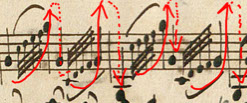
Ex. 7 Implied gestalt image schema of scale in the annotation of the throwing gesture from Telemann’s Don Quichotte, ‘Sanche Panse berné’, (Telemann 17??).
The throwing gesture in Telemann’s Sancho Panza (see V1aT1) follows a similar trajectory. In my video analysis, a clear difference emerged between Gesturist and Soundist strategies. The implied 'increase' in the image schema of scale (Ex. 6) will for a Soundist entail the increase of dynamics throughout the scale figure with an accented and short articulated top note. A Gesturist embodies the scale figure as a throwing gesture, applying the image schema of scale to the bodily action, with a main throwing effort initiated on the scale figure. The top note becomes a moment of a release, as if letting Sancho fly.
There is a danger of seeing these image schemata as illustrations of the topography of a musical score. We must remind ourselves to read them and feel them as they resonate with our experiential bodies. As Johnson explains: ‘Image schemata have a certain kinaesthetic character. They transcend any specific sense modality, though they involve operations that are analogues to spatial manipulations, orientation, and movement’ (Johnson, 1987, p. 25).
It is the energy contained in embodying the scale figure that determines the volume of the 'throw'. The gestalt image schema of containment and out can be employed to describe the body movement action in the throwing gesture.

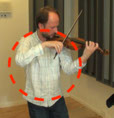
Ex. 8 containment (p. 23)

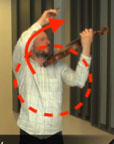
Ex. 9 out (p. 32)
For the sword fighting action, I apply the image schema of counterforce (Johnson, 1987, p. 46). Each bow/sword movement is met by the counter attack of the resistant force.
![]()
Ex. 10 The gestalt image schema of counterforce (Johnson, 1987, p. 46).
Another applicable image schema for the sword fighting action is the image schema of diversion (Johnson, 1987, p. 46). Two sources of force collide, resulting in the change of the course in both trajectories. Johnson’s gestalt image schema conspicuously resembles the image I annotated into my music to illustrate the bow action representing sword fighting (Ex. 11)


Ex. 11 Gestalt image schema of diversion (Johnson, 1987, p. 46).
Employing this schema will bring the body movement into the centre. Each impact of the bow-stroke implies an abrupt body movement. The following pictures (Ex. 12) capture the four positions of the body at the four consequent barlines of the attack motive. The time span between the positions is less than a second.
 ’
’


Ex. 12 Applying the gestalt image schema of diversion (Johnson, 1987, p.46) to the sword attack bowing action drawing on body movement.
Vid. 2 Sword Attack in the Gesturist strategy implying the image schema of diversion.
In Video essay 'Sighing' (V1c). I observed different movement trajectories between the real action of sighing (the sighing gesture coinciding with a respiration and the body sinking down) and the representation of the sigh on the violin (the sigh gesture coinciding with a rising body movement). In both trajectories however, there is a prominent weight on the down beat, where the respiration implies the release of the resistance followed by a moment of inertia. I will encounter a similar phenomenon, where the downbeat weight triggers an upward movement, in an assimilation of the dance movement impulse called élevé (V2aT1).
The feeling of overcoming a resistance on the sigh motive connects the gesture with the gestalt schemata of removal of restraint (Johnson, 1987, Ex. 13). Moving against a resistance (sigh gesture), the moment of inertia (the rest), and the forward movement (pathetic inhalation) are three aspects of body movement that determine the timing structure by a series of temporal stretches and forward motions.
 .
. 
Ex. 13 Stretching the time and moving forward compared to the gestalt image schema of removal of restraint (Johnson, 1987, p. 47).
The cyclic sequence of rises and sinks in the body movement trajectories recall Johnson’s gestalt image schema of cyclic climax (Johnson, 1987, p. 120).
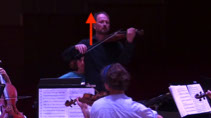
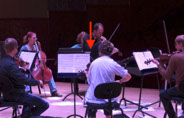
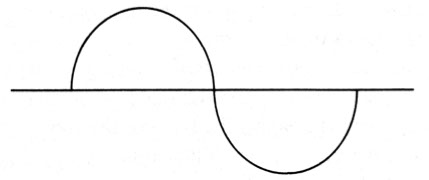
Ex 14 A comparison of the body movement sequences of sighing gesture and gestalt image schema of cyclic climax (Johnson, 1987, p. 120).
The application of Johnson’s embodied image schemata in the analysis of gestures found in the section 'Mimetic action' allows me to explore the relationship between the real physical actions implied in the narrative content of the music and their metaphorical elaboration in the body movements of a violinist. The actions I am dealing with in section V1 belong to a general experiential arsenal which form part of human behaviour in daily life.
In the next section (Video group 2 'Dance'), I am operating in a different, possibly less spontaneous and less personal, context. My body movements cannot rely on the metaphorical elaboration of the embodied experiences (as in V1 'Mimetic action'). To incorporate dance characters into my body movement vocabulary, I have to explore the external world of dance step-units and dance body movements. Nevertheless, Johnson’s embodied image schemata provide a tool for deconstructing the historical and technical surface of these dance forms, helping me to assimilate the dance patterns by analysing movements from the perspective of the schemata (including, for example, transfer of weight, lift, bounce, bend, and sustain).